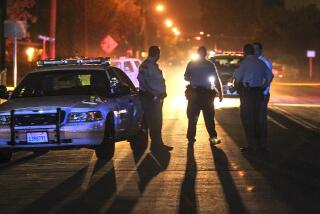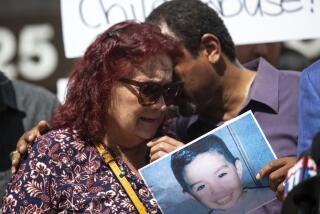Long Beach boy’s death shows need to track abuse reports, experts say
Early last year, Long Beach police received a phone call about a toddler who might be in jeopardy.
The boy’s name was Josue Rey Maldonado. He was 1 1/2 years old. His paternal aunt had been baby-sitting him at the mobile home park where she lived.
When the boy’s mother came to pick him up, the aunt decided the mother might be too intoxicated to care for him and called the police.
In retrospect, the seemingly small gap between what happened and what might have happened after police got the call raises questions about whether Josue, who died six months later, could have been saved — and offers a window into a broader debate about how to prevent the death of children because of abuse or neglect.
Academics and authorities who study child abuse have created lists of best practices for social workers and other authorities who have opportunities to work with children who may be at risk. These include:
•Focus on the most vulnerable children, especially those younger than 2.
•Train social workers by having them role-play what they will encounter in the field, using actors to realistically simulate an array of difficult and complex family situations they will face.
•Assign the most experienced workers to investigations.
But according to many people who work to limit child abuse, the most important solution is almost counterintuitive: Every type of agency that interacts with families should gather and pass on to a central clearinghouse as much information as possible after any accusation that a child is in danger — even if the accusation doesn’t seem credible.
In the case of Josue, known to family and friends as Josh, the boy’s aunt, Cecilia Cervantes, told The Times in a recent interview that she had called Long Beach police because the mother had been sending cellphone pictures throughout the day depicting herself drinking. She said she also thought the mother might be on drugs.
Long Beach police officers arrived soon after the call and determined in interviews, correctly, that the family was embroiled in a custody dispute.
The officers observed the mother’s appearance and speech and decided that she showed no signs that she was intoxicated. Deputy Police Chief Richard Rocchi said in a recent interview that the responding officers had no probable cause to order tests.
Officers left the home after 22 minutes, allowing the mother to take Josue away in a car driven by another family member.
Six months later, in August 2014, the boy was bludgeoned to death.
According to Department of Children and Family Services investigation records, Josue’s mother told authorities that she left her son with her boyfriend the night before and returned to find him bruised and unresponsive. Josue arrived at the hospital with a skull fracture and bruising “all over his body,” including on his hairline, face, ears, abdomen, chest, arms and legs, according to a petition filed in Los Angeles County Superior Court to remove a surviving sibling from the mother’s custody.
No one has been arrested in his death. But in hindsight, experts say that earlier call to Long Beach police may have been a missed opportunity.
Rocchi said police officers who responded to the call from Josue’s aunt acknowledge that they didn’t check for past referrals in the cross-reporting system for Los Angeles County law enforcement agencies — known as E-SCARS — and instead only checked their own department’s database to see if other officers had visited the home before. They hadn’t.
They also decided not to share the aunt’s allegation in that earlier call with the child abuse hotline, the single entry point for allegations by the public of abuse and neglect and for law officers and workers in other agencies to report those allegations.
Those seemingly small judgment calls, in retrospect, can have serious consequences, child welfare experts say.
Emily Putnam-Hornstein, a USC professor and one of the state’s leading researchers of child welfare data, recently performed a comprehensive analysis of 4.3 million children born in California between 1999 and 2006 and found that a referral to the counties’ child abuse hotline remains the best indicator of risk for a child.
That finding surprised her, she said, because, as every law officer and social worker knows, many calls are made by jilted lovers, angry neighbors and others who use the anonymous caller system to settle scores that have nothing to do with child abuse.
Conventional wisdom among child protection agencies has been that an officer or social worker’s ability to parse truth from fiction is a key skill in the detection of abuse. But Putnam-Hornstein’s research does not support that belief.
If someone calls a hotline to report a child at risk, that child is twice as likely to die of mistreatment as other children. Whether social workers judged the information conveyed in a call to be valid or false had a negligible bearing on the child’s risk, Putnam-Hornstein found.
People calling to report abuse, she said, are often in a position to see behavior that a social worker might not, which is why authorities should pay closer attention to what witnesses and other agencies report seeing, even if no one has verified the threat, she said.
The process of recognizing abuse, she and other experts say, is like assembling a mosaic. Each piece of information about a child may in itself seem inconsequential, but putting the pieces together can create a picture that helps to “detect acute or chronic risk,” Putnam-Hornstein said.
That’s why child welfare leaders encourage law enforcement officers and other authorities to “cross-report” even when those reports strike them as unfounded, and to consult other databases that child welfare agencies have built to share information about a family’s history, including hospital visits and suspicious injuries.
Indeed, the state’s mandated reporting act dictates that “mandated reporters” must cross-report allegations where there is reasonable suspicion of abuse. But some agencies, including the Long Beach police, have defined their responsibility to report more narrowly than others.
Rocchi said that Long Beach police officials interpret California’s mandated reporting law to mean that they are only required to pass on reports received by the public to the Department of Children and Family Services if the officers have deemed the call credible after at least some investigation.
But Dan Scott, a former Los Angeles County Sheriff’s Department official who helped design the county’s procedures to ensure that law enforcement agencies play a strong role in protecting children, argues that the law requires all police agencies to cross- report even those claims of child abuse that officers are unable to substantiate.
Scott said that if the Long Beach department had informed the Department of Children and Family Services of Josue’s aunt’s call, for example, social workers would have been required to respond to and closely evaluate the allegations.
And they would have known what the police did not: That the mother’s past drug and alcohol use had played a role in a prior finding of neglect — all of which is included in the boy’s child welfare case file.
In the months leading up to that supervision, the file shows, the department found substantial evidence of neglect after investigating complaints that Josue had been abandoned, that his biological father — who was in state prison at the time of the boy’s death — had used methamphetamine while living with the mother, and that the boy had been present during a domestic-violence incident involving a gun. Josue’s mother did not respond to repeated requests for comment about the case.
Scott, who has examined many child deaths to determine what went wrong, says that if the Long Beach police had known about Josue’s troubled background, or if the Department of Children and Family Services had known about the aunt’s additional allegations, one agency or the other — or both — would almost certainly have scrutinized Josue’s circumstances even more closely — and the boy might still be alive.
More to Read
Start your day right
Sign up for Essential California for news, features and recommendations from the L.A. Times and beyond in your inbox six days a week.
You may occasionally receive promotional content from the Los Angeles Times.







